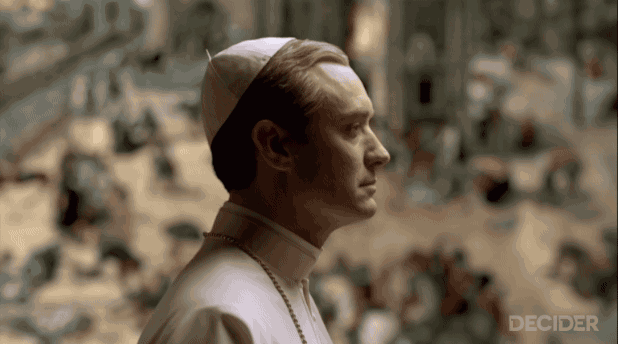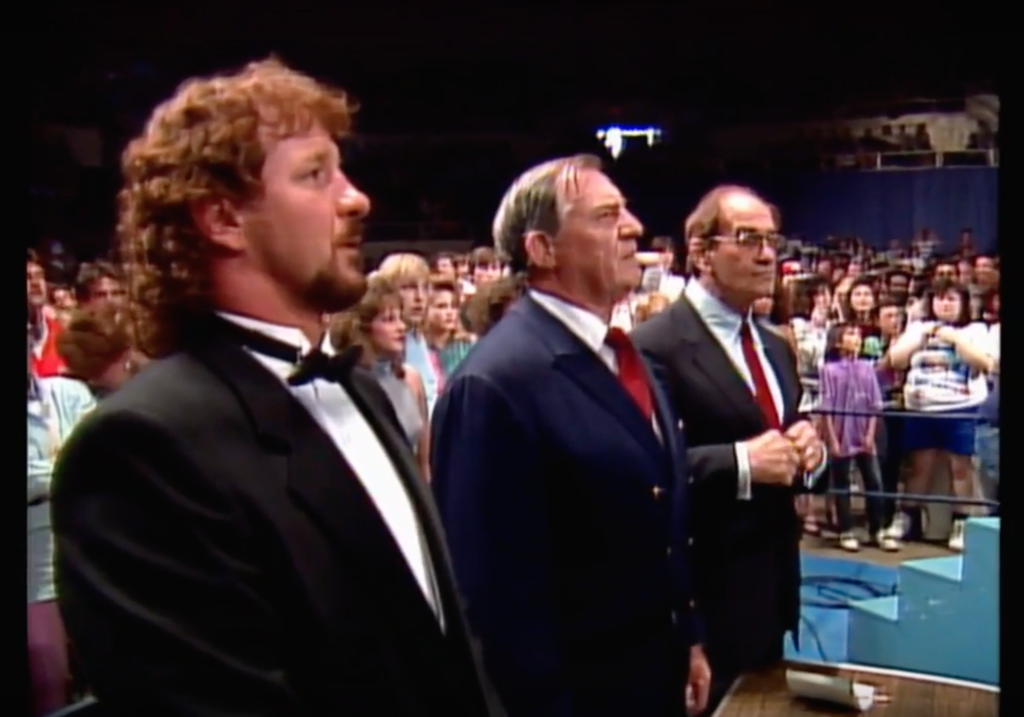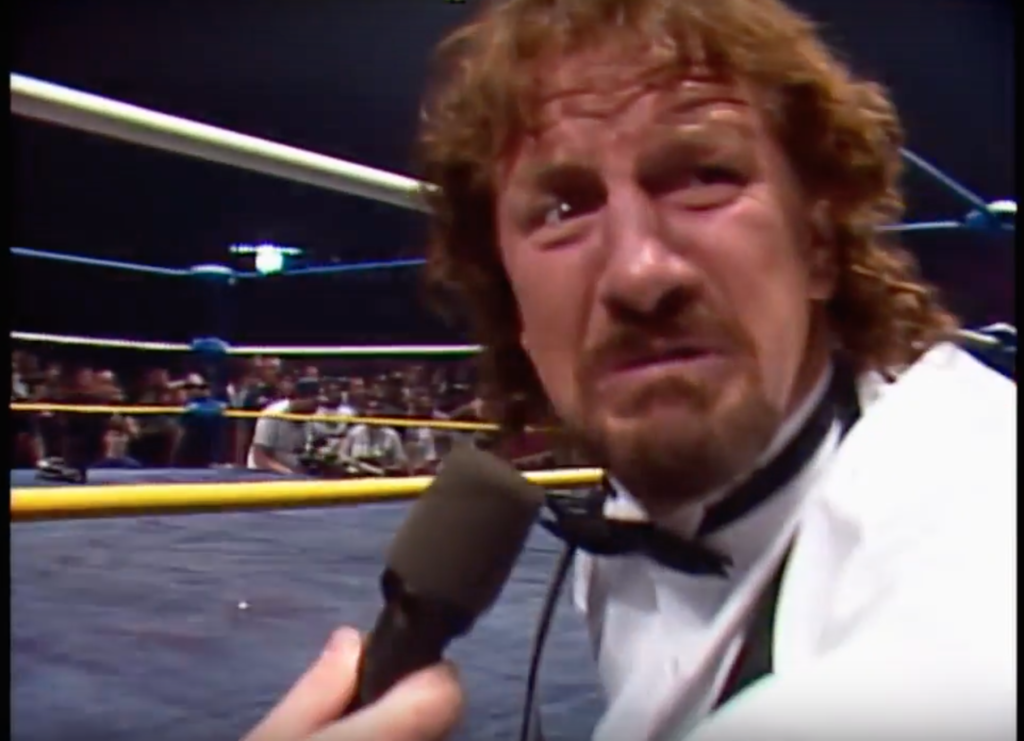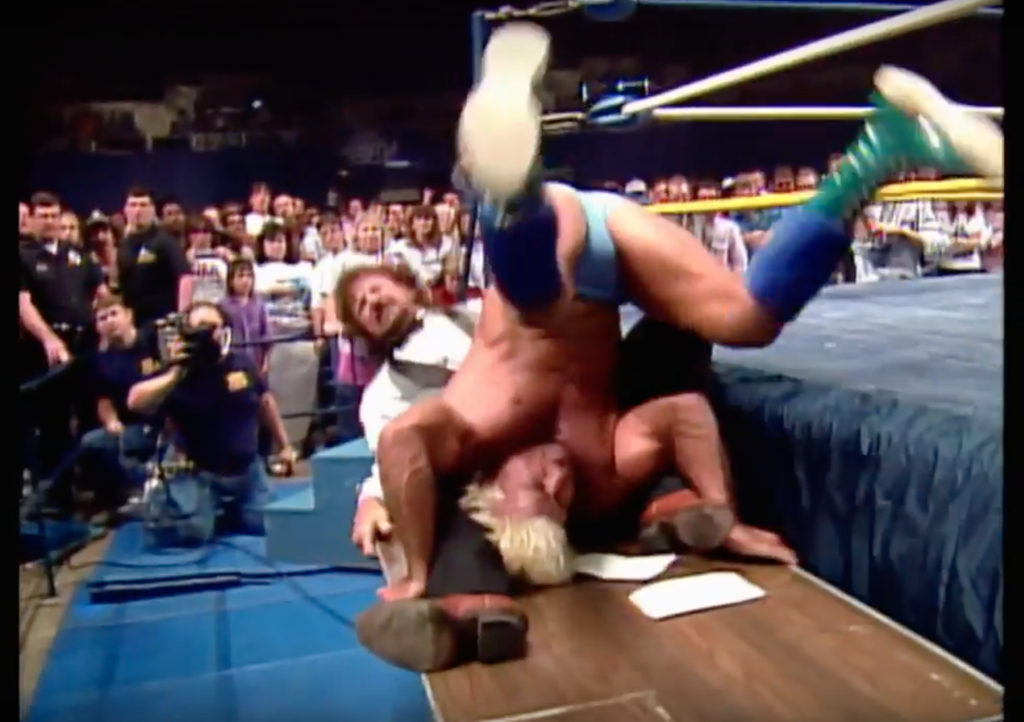Posts Tagged ‘wrestling’
Stream It Or Skip It: ‘Wrestlers’ on Netflix, a Gritty and Theatrical Look at the Pro Wrestling Underground
September 14, 2023Our Take: Professional wrestling is a truly fascinating, uniquely American art form and subculture. Long before I became a weekly viewer — fully three decades removed from when I thrilled to the likes of Hulk Hogan, Andre the Giant, and the Ultimate Warrior as a child — I was drawn to its history, its personalities, and its jargon, which remains one of the most valuable lenses through which to see the world I can think of. (The concept of “kayfabe,” the agreed-upon un-reality in which pro wrestling conflicts exist, is worth the price of admission alone.)
Wrestlers depicts this riveting demimonde through the memorable personae of people living in it. Booker (i.e. head writer) Al Snow, co-owner and promoter Matt Jones, and the Julia Garner character-in-waiting HollyHood Haley J are instantly recognizable character archetypes: hero, villain, and antihero.
Director Greg Whiteley wisely contrasts the emergence of these figures within the non-fictional narrative (at least by reality-show standards) on one hand and the pre-planned presentation of OVW’s faces and heels on the other. Effectively, he’s announcing that the show will work much like a wrestling storyline; like many magicians, he tells you what he’s doing before does it.
I, for one, am impressed — skeptical though I might be of the way he manipulates events with standard reality-show drama. Do I wish this were a real documentary that just so happened to catch a company at a pivotal moment, instead of what it likely is: a reality show, where Jones and Snow and Haley and the rest have been encouraged off-camera to act their parts and play up conflict, especially around the risky tour that just so happens to coincide with the series’ production? Yes I do. Will it stop me from watching? No, it probably won’t.
How Queer Pro Wrestlers Are Handling America’s Anti-LGBTQ+ Heel Turn
August 9, 2023Pollo del Mar wants to be hated. As a bad guy (or heel) in the NWA—the National Wrestling Alliance, a professional wrestling company owned and operated by the Smashing Pumpkins’ Billy Corgan (no shit!)—it’s her job to get heat, i.e. the boos and jeers and chants that separate professional wrestling’s villains from its heroes. There’s just one problem: She’s a drag queen, and it’s made her too popular.
“I would love to be a true heel in the world of professional wrestling,” says Paul Pratt, Pollo’s real-world alter ego. “But it’s ultra-challenging, because the moment I walk through the curtain, people erupt. They know that drag queens are supposed to be sassy and bitchy, so even when I say horrible things to people, they’re like ‘Yass, bitch, read me for filth! The library is open!’ It’s so frustrating. I just called you a piece of trash! You’re not supposed to like it!”
Stream It Or Skip It: ‘American Nightmare: Becoming Cody Rhodes’ on Peacock, an Uplifting Pro Wrestling Biography That Raises More Questions Than It Answers
July 31, 2023But that’s just it: This a documentary about a current WWE wrestler, produced by WWE. That means you’ll be hearing a lot of the bizarre, cult-like lingo developed by Vince McMahon to describe the product he’s been selling for forty-plus years. For example, both the narration and multiple interview subjects, from Cody on down, use the sanitized word-salad phrase “sports entertainment” in place of “professional wrestling”; it’s a McMahon innovation you will never hear a human being not on WWE’s payroll say, unless they’re doing a bit.
Similarly, the adversity Cody faced during his initial WWE stint — bad gimmicks, bad ideas, writers and executives who refused to listen to him — is treated like some kind of natural phenomenon rather than the result of actual decisions made by people with names and addresses. The result is an onslaught of passive verbs that would make reporters about “police-involved shootings” blush, in which Cody is repeatedly fucked over by figures unknown.
But it’s a documentary’s job to make the unknown known, right? Like, when Cody says his demand to revert to “Cody Rhodes” from “Stardust” after his dad’s death “was met very much poorly” — met very much poorly by whom? Elsewhere, Brandy describes the situation that kept her husband down thusly: “Somebody said to somebody, ‘Not you.’” Who said it? To whom did they say it? Who are the somebodies? If “they” wouldn’t let Cody do what he wanted, who are “they”?
The answer, of course, is Vince McMahon himself, the man who for decade after decade has overseen WWE’s creative decisions on the most macro and micro of levels alike. The documentary treats this man like Zeus, a figure of might and legend who occasionally descends from his Stamford Olympus to bestow his blessings upon the worthy. Cody gets there eventually, but the years in which McMahon — who it’s widely believed bore a grudge against his one-time rival businessman Dusty Rhodes to the man’s dying day, even during the periods during which Dusty worked for WWE — kept him down are glossed over.
This is to say nothing of the well-documented series of incidents in which McMahon engaged in illicit sexual conduct with his own employees, then paid millions in hush money to cover it up. Or about how he “retired” when this news broke, then forced his way back into the company to oversee its sale to perhaps the only potential buyer willing to leave him in charge, Ari Emanuel’s Endeavor — which also owns UFC, run by the similarly politically reactionary and personally abusive Dana White. Or about his Succession-like power plays against his daughter Stephanie and her husband, former wrestler Paul “Triple H” Levesque, both of whom hold (or held, in Stephanie’s case) executive positions within the company.
McMahon’s conduct (and of his years-long track record of creative bankruptcy; whatever juice the guy once had, it dried up 20 years ago) got me to swear off watching WWE shows unless and until he’s gone for good. Stand-up guy though he might be, the same cannot be said of Cody. All of this is worth exploring in a way an official WWE documentary can and would never do, yet it’s exactly this stuff that would make the doc worthwhile.
Dark Side of the Ring Exposes Wrestling’s Seedy, Sensational Secrets
May 7, 2021Is it real or is it fake? Is it a sport or is it an art form? Is the story what goes on inside the ring or what happens behind the scenes? These questions animate any serious discussion of professional wrestling; the key to understanding this American pastime is that the answer is yes, on all counts.
No series has understood this better than Dark Side of the Ring. Billed as the most-watched show in the history of Vice TV, Dark Side digs into the history of professional wrestling for its most controversial and criminal moments, which it portrays with genuine style and considerable compassion. Returning for its third season on May 6, it’s a must for true-crime junkies and wrestling aficionados alike. You don’t need to be a pro-wrestling scholar to find it a gripping, moving watch.
I wrote about Dark Side of the Ring for Vulture in anticipation of last night’s season premiere. I put a lot into this one and I hope you enjoy it.
10 Off-the-Beaten-Path Shows To Keep You Busy During This Neverending Quarantine
May 7, 2020Grappling with the big questions?
Try The Young Pope and The New Pope (HBOGo/HBO NOW)
Here’s the deal: Italian director Paolo Sorrentino’s outrageously bold pair of series take on the iconography and ideology of the Catholic Church with a sly sense of humor and a knack for surreal visuals. The Young Pope stars Jude Law as Lenny Belardo, an “incredibly handsome” American elected Pope by his brother cardinals, whom he comes to rule with an iron fist. The New Pope, which is simply The Young Pope Season 2 by a new name, introduces John Malkovich as Belardo’s successor, the dandyish Englishman Sir John Brannox. Fully loaded with eye candy, both shows grapple head-on with the power of faith and the mystery of love—or is that the other way around? Your jaw will drop even as your mind expands.
I wrote a guide to 10 off-the-beaten-path shows to binge-watch during quarantine for Decider. This one was a long time in the making—I hope you dig it!
Pro Wrestling in Empty Arenas Is the Weirdest Show on Earth
March 17, 2020Are professional wrestlers just the world’s most muscular theater kids? To quote wrestling legend “Stone Cold” Steve Austin, who appeared on last night’s episode of WWE’s Monday Night Raw: Hell yeah.
Broadcast live without an audience for the first time in history, both Monday Night Raw on the USA Network and last Friday’s episode of Smackdown on Fox stripped wrestling down to its bare essentials: a ring, a microphone, and wrestlers to use both. The result was less like the WWE’s usual played-to-the-rafters gladiatorial spectacle and more like tech week for a black-box production. It showcased the performers at their weirdest, wildest, and most, well, theatrical.
I wrote about the strangeness of wrestling without crowds for Vulture.
The Boiled Leather Audio Conversation: Horror and Wrestling
February 17, 2020New column alert!
October 23, 2019I’ve started a new column about film called My Favorite Movies, which will cover exactly that. The inaugural installment: Eyes Wide Shut. It’s available for my Patreon subscribers at the $5/month tier. I hope you dig it!
With that in mind I’ve experimented with making my pro wrestling column, Sweeping Up the Eyeballs, free this week. I hope you dig that too!
Inside NXT’s Two-Front Wrestling War
October 3, 2019“Raw and Smackdown are like this band you were into when they first started,” Levesque tells me hours before the USA Network premiere. “They were small, and no one had heard of them, and they were the greatest band ever, right? Then, five, six years and two, three albums down the line, they go mainstream and hit it big. Casual people are all into them because they’re selling out stadiums, and you’re like, ‘That is the worst piece of crap sellout song they’ve ever made. You’ve got to go back and listen to these first two albums!’
“Raw and Smackdown are the thing that want to try to grab everyone,” he continues. “NXT? I want to grab people at that base level, where they started, where this is the greatest band ever. There’s not as many of them, but they’re super-engaged from day one. We’re gonna be laser-focused on the stuff that the more passionate fans will care about — the pure product, as opposed to just the spectacle.”
What a Time to Watch Wrestling
September 19, 2019I’ve got my media-consumption hands full. I’m a full-time freelance critic who spends pretty much every free moment watching some show or movie or listening to some album or reading some comic I’m getting paid to write about. I’m a parent of two kids who have their own faves, for which I come along for the ride. My partner, the smartest person I’ve ever met, is a cartoonist and aesthete, adding another set of artistic reference points for me to follow. I don’t watch “real” sports, admittedly, but I play the occasional video game while high, and I think that counts.
Which is why I can tell you without fear of contradiction that wrestling — freaking professional wrestling — is as exciting and engrossing and life-affirming and generally excellent as all of the above. I enjoy it with a purity I didn’t think possible. I think you might, too. Because here’s the thing about being a wrestling fan today: 20 years’ worth of advances in technology, representation, and pure athleticism have made the sport smarter, better, and more fun than ever before.
I wrote about why this is such a great time to get into wrestling for Vulture. This piece was months in the making and means the world to me. I hope you like it, and if you like it I hope you share it!
161. Terry Funk Trilogy
June 10, 2019The same year he starred as Morgan, the man who tells Patrick Swayze he’d heard he has balls big enough to fit in a dump truck, in Road House, Terry Funk was a peripheral participant in what is widely considered to be the greatest series of wrestling matches of all time.
In 1989, “Nature Boy” Ric Flair and Ricky “The Dragon” Steamboat battled back and forth for the NWA World Heavyweight Championship in three major televised events: Chi-Town Rumble, Chicago, February 20; Clash of the Champions VI, New Orleans, April 2; and the inaugural Wrestlewar, Nashville, May 7. Each match ran over half an hour of continuous wrestling, significantly more so in the case of the Clash of the Champions fight, which was a best-2-out-of-3 falls encounter. Flair was a flamboyant bleached-blonde self-styled playboy and the greatest heel in wrestling; the contrast with Steamboat, with his raven hair, his presentation as a serious martial artist and working-class family man, and the purity of his babyface goodness, sold itself.
But the wrestling formed the real narrative and set a new standard. Naitch and the Dragon chopped, stretched, tossed, and slammed the holy hell out of each other in epic back-and-forths in which each individual body part being worked on felt like a pivotal supporting character. The trilogy charted Steamboat’s upset capture of the title from longtime champion Flair in Chicago, his successful defense of the belt in a controversial finish at the Superdome, and his almost anticlimactic defeat by Flair to regain the championship in Tennessee. (They fought each other at off-air “house shows” dozens, perhaps hundreds, of times; some of these fights, by their own account as well as those of contemporary observers, were even better than the big three canonical bouts.)
These matches are available on WWE’s proprietary streaming service, and may also be located with minimal google-fu on YouTube or one of its knockoffs. You can sit and watch all three matches back to back and feel as if you’re watching an intimate epic, The Return of the King crammed into the deliberation room from 12 Angry Men. If you want to be entertained and awed by the world’s most lucrative outsider artform, I can’t recommend “the trilogy” highly enough.
I bring this up not only because I just watched the trilogy for the first time, but because Terry Funk’s presence was such a treat for a Road House mark like myself. While absent for the Chi-Town Rumble fight, he was one of two ringside commentators during CotC, as well as a judge and…let’s say “audience participant” at Wrestlewar. I’ll tell you this, fight fans: Anyone who thinks Terry Funk isn’t one hell of an actor needs to listen to and watch those last two matches.
In the first, Funk is largely an offscreen presence, and an ebullient, gracious, and sweet-natured one at that. His distinctive, soft tenor rasp provides a sense of almost childlike delight at the herculean feats of Steamboat and Flair in the ring; if “I’m just happy to be here” had a voice, it would be Terry Funk’s during this match. Where is the man who called Dalton an asshole and a dead man?
He’s biding his time until the following month, that’s where he is. That is when, while Steamboat is still exiting the arena and his prior commentary colleague Jim Ross attempts to interview the triumphant Flair in the ring, Funk awkwardly inserts himself, repeatedly congratulating the new champ. It gets weirder and rings phonier as the segment goes on, and Flair, whose display of stamina and guts during the whole titanic series of matches had largely won over the crowd at a time when the line of demarcation between heel and face was much firmer than it is today, gets pricklier. When Funk says he’d like to be the first to challenge Flair for the title, it feels inevitable, and Flair’s pushback—that there’s an entire ranking system of top contenders, all of whom were around while Funk was off hobnobbing with Sylvester Stallone in Hollywood—feels justified.
Funk, as you might have guessed, disagrees, and goes absolutely apeshit.
He suckerpunches Flair, blasts him right out of the ring, and goes to town on him with the security railing, with a table, with a chair. In one spot that’s particularly frightening now, after a few intervening decades of broken necks and CTE, he piledrives Flair’s skull directly into the tabletop, toppling the whole edifice to the ground as they collapse onto it afterwards. Throughout, Funk is so furious he actually appears to start crying, tearing off his tuxedo jacket and screaming “You think you’re better than me???” at the defenseless champion while shrieking at the aghast and angry crowd.
Less than two weeks later, on May 19, Road House debuted. Along with the Clash and Wrestlewar matches, it comprises a Terry Funk trilogy of its own.
I feel I understand Morgan the bouncer a bit better now after watching Steamboat/Flair II and Steamboat/Flair III. After his genial turn as an announcer I can see how he might have sweet-talked Frank Tilghman into hiring him, and perhaps even initially persuaded his coworkers to like him. After his psychotic rampage, I can see why no one dared to fire him despite his manifest unfitness for the job, and why Brad Wesley kept him on the payroll to protect his nephew and his investments. After both, I see why Rowdy Herrington cast the person he cast for the role. You could say that Terry Funk brought a lot to the table.




